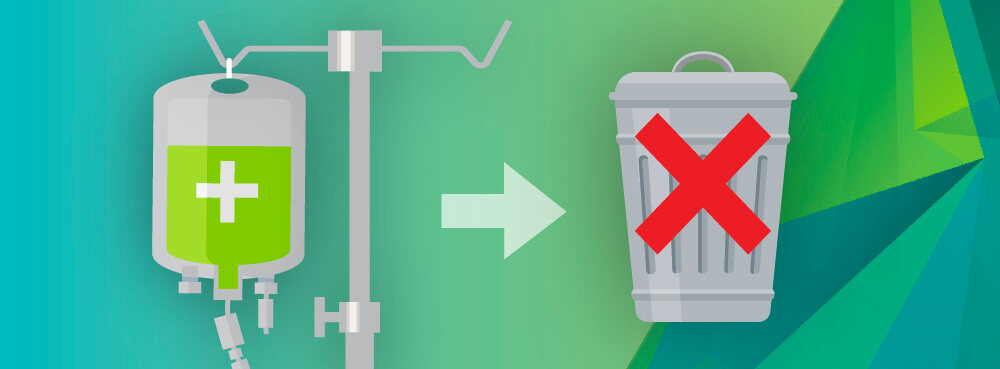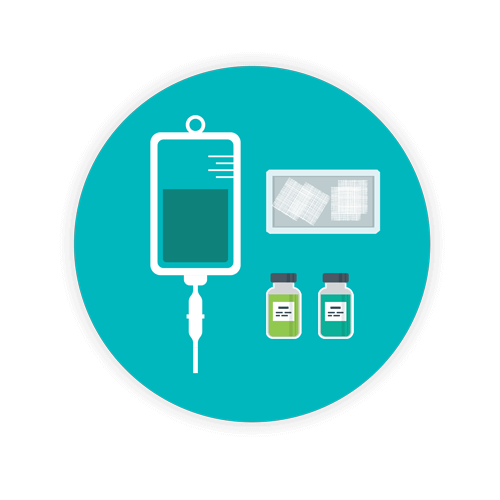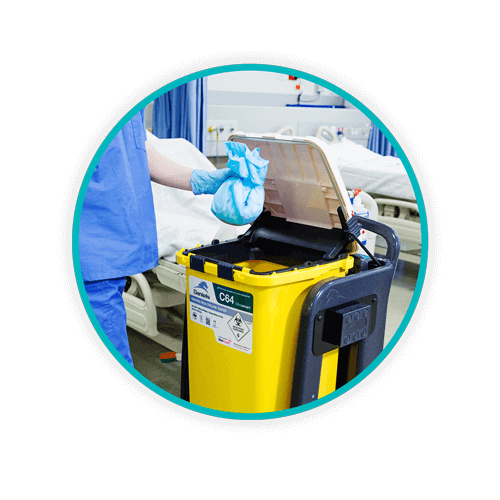How to Dispose of Trace Chemotherapy Waste

Compliant disposal of chemotherapy waste is essential for any medical facility providing cancer treatments. That waste includes more than merely the drug itself. Such waste can also include ancillary supplies like IV tubing, the vials the drug comes in, the syringes used to deliver the drugs, as well any item that might have been contaminated by such drugs, including bedding, personal protective equipment (PPE), and so forth.
All personnel that come into contact with this waste stream should be able to identify the difference between bulk and trace chemotherapy waste, and whether it is a listed or characteristic hazardous waste so that proper handling, packing, labeling, transport, and disposal processes are followed.
TOPICS WE WILL COVER:
2 / Difference between trace and bulk chemotherapy
3 / Disposal of trace chemotherapy
4 / Transporting chemotherapy waste off-site
Chemotherapy waste basics
Chemotherapy drugs listings for P- and U-listed drugs can be found on the Environmental Protection Agency’s (EPA) website in listed or characteristic hazardous waste tables. The list contains brand and generic names, as well as EPA waste codes. The Resource Conservation and Recovery Act (RCRA) also provides specific details regarding listed characteristics and mixed radiological wastes. 
A few common chemotherapy drugs listed as hazardous include but are not limited to:
- Leukeran (generic Chlorambucil) – Waste Code: U035
- Trisenox (generic Arsenic Trioxide) – Waste Code: P012, D004*
- Alkeran, L-PAM (generic Melphalan) – Waste Code: U150
State government websites also have information on hazardous drugs and how they are to be disposed of. For example, in Wisconsin, the Department of Natural Resources has information regarding hazardous waste at dnr.wi.gov.
A waste can be hazardous depending on its characteristics, such as corrosivity, ignitability, reactivity, and toxicity. Listed hazardous materials can be spent (used) and are defined as F- and K-listed wastes. Commercial chemical products are listed as a U- or a P-listed waste.
A container that holds a U-listed drug substance can be defined as empty per RCRA, but only when the volume that remains in the container amounts to less than 3% of the total capacity of the container by weight. Note that P and U lists include hazardous pure- and/or commercial-grade formulations of certain unused chemicals. Turn to specifics for U-listed wastes here.
*This code is applicable to wastes that exceed the established EPA thresholds for that material.
Difference between trace and bulk chemotherapy waste
Chemotherapy waste is typically defined as either trace chemotherapy waste or bulk chemotherapy waste. Any item that contains trace chemotherapy waste not only includes the drug vial or syringe itself, but also includes IV bags, IV tubing, and related equipment. This type of waste is also defined as RCRA empty because it contains less than 3% of its original volume.
Put another way, any container that has held a U-listed substance can be defined as RCRA empty when no more than 3% by weight of the total capacity of the container remains. (see § 261.7 – Residues of Hazardous Waste and Empty Containers found in Title 40 CFR – Code of Federal Regulations – Protection of the Environment.)
In such a case, this type of listed waste is defined as a trace waste that can be managed as regulated medical waste as long as it’s disposed of in a compliant and clearly labeled container. Trace chemotherapy containers are typically yellow, while bulk chemo containers are often black. Every single container must be labeled clearly regarding its contents. If the material does not meet the standards of the regulations, it is considered hazardous waste and should be handled and stored as such.
Bulk chemotherapy waste is any chemotherapy waste that is not RCRA empty. Don’t let the term “bulk” confuse you. Bulk chemotherapy waste also includes sponges or other materials that might be used to clean up a spill. It can also include “visibly” contaminated PPE. Other types of bulk chemotherapy waste include full bottles, bags, or vials of U-listed chemotherapy drugs.
Bulk chemotherapy waste also includes any type of container or bag that has held a chemotherapy agent that does not qualify under the RCRA empty rules. Additional bulk chemotherapy waste can include any type of material used to clean up a spill.
Disposal of Trace Chemotherapy waste
In addition to federal guidelines for trace chemotherapy waste, you must also abide by the rules and regulations of your state. As an example, New Hampshire’s Department of Environmental Services provides specific information regarding trace chemotherapy waste in regard to type, such as “softs,” sharps, and containers. In New Hampshire, the guidelines state that containers that have contained chemotherapy or antineoplastic drugs must be empty before they can be considered “trace” chemotherapy waste. That waste is to be placed in yellow waste containers to be incinerated. 
The term “softs” in New Hampshire implies and includes PPE tubing, wipes, or other products used in the chemotherapy process that must also be disposed of in yellow containers and incinerated. Sharps and/or needles must be disposed of in a compliant sharps container and managed as a regulated infectious waste.
In Wisconsin, trace chemotherapy waste must also be segregated. If a non-hazardous trace chemotherapy waste is mixed with a solid or an infectious waste, it must be managed as a trace chemotherapy waste and incinerated.
However, non-hazardous chemotherapy waste can be managed by placing it in a compliant, rigid, leak-proof, and puncture-resistant container that has been appropriately labeled as “Trace chemotherapy” and “Incinerate only” before being transported to an approved waste incinerator.
“Soft” chemotherapy waste can be placed in rigid plastic containers or plastic bags (or a doubled plastic bag that meets or exceeds 165 grams resistance) and then sent to an incinerator that has been approved for such waste disposal.
Refer to your state government website for detailed information regarding chemotherapy waste storage and disposal considerations that meet or exceed those of the federal government.
Transporting Chemotherapy Waste Off-Site
All chemotherapy or other pharmaceutical wastes must be segregated into EPA- and Department of Transportation (DOT)-compliant containers that meet federal and state DOT regulations. This is essential from the point of origin, prior to transportation, and through the disposal process.
Hazardous waste manifests must also be filled out by the generator and follow along the transport process with the shipment until its final disposition. Use of appropriate labels and warning placards for the vehicles transporting such waste must also be compliant.
Note – It is the medical waste generator’s responsibility to make sure that compliance is maintained, even after the waste leaves your facility. This is the cradle-to-grave approach of medical waste management – from the point of origin to its final disposition.
Neither trace nor bulk chemotherapy waste should ever end up in a landfill, nor disposed of down a drain.
Daniels Health Guidance and Resources
When it comes to any type of chemotherapy waste, turn to Daniels Health for resources and guidance for proper collection, storage, labeling, and disposal processes that meet federal and state requirements. We know the regulations can be redundant and often confusing, but compliance is key to avoid fines and penalties. For information, products, and services offered by Daniels Health in your state, call us today.
Let's Talk!
Your time is valuable, and we don’t want to play hard to get. You can either phone us directly on the details listed on our contact page, or feel free to fill out this short form and one of our team members will get back to you as quickly as possible.
